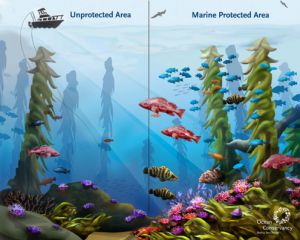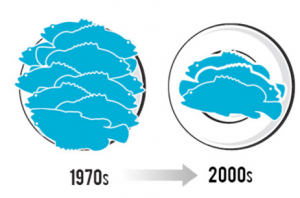Messages
Step 4: Make Your Message Matter
The next step is developing key messages, which include the action(s) desired (also referred to as “call to action”) from the target audience. If effectively crafted, these will influence the attitudes and affect the behaviors, or simply increase the knowledge, of your target audiences.
Watch a short presentation about making your message matter:
- Make an emotional connection
- Provide the rationale for taking action
- Be clear about what you want people to do (the call to action)
- Make your message concrete
- Make your message simple, avoid jargon
- Highlight the benefits
- Be credible
- Tell a story
1. Make an Emotional Connection
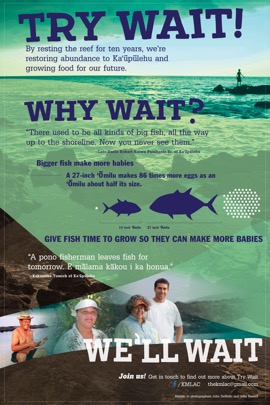
Poster created by the Kaʻūpūlehu Marine Life Advisory Committee to build support for a ten year marine reserve. Example of a personal positive message (click image to enlarge).
Emotions are more likely to spur action than reason/logic
The human brain processes information either experientially or analytically. The experiential processing system controls your survival behavior, and is your source of emotions and instincts. Your analytical processing system is where you analyze scientific information. The experiential processing system is the stronger motivator for action, but it’s a good idea to create messages that apply to both types of processing.
Positive messages motivate behavior
To appeal to peoples’ experiential processing systems, we need to make an emotional connection. But different emotions motivate different behaviors. For example, fear or sadness, or scare tactics, are powerful attention getters and can be effective for short term fund raising efforts, but not for behavior change. In fact, they can lead to apathy. Messages that inspire and empower, and present more solutions than problems are more powerful drivers of behavior change.
Make it personal
Emotional connections that connect to what our audience cares about – to their core concerns and values – are more likely to motivate listening, action, and behavior change. Make it clear how your action affects and benefits your audience personally.
2. Provide the Rationale for Taking Action
Key messages must explain why your audience should change their behavior or support your cause. It must be clear both what’s in it for them and that it’s urgent for them to act now. These guidelines will help you distill technical and scientific information for your key audiences.
Offer science, but keep it simple and visual
Most people see and understand the world through images, not lists of numbers or graphs, and so it’s best to communicate through images, simple graphics, or one or two thoughtful statements. Translate and interpret technical language in scientific reports into simple, engaging summary statements.
Keep visuals and graphics simple, so it’s clear to your audience what information you want them to focus on.
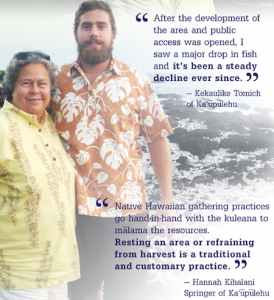
Example of sharing personal observations from the Kaupulehu Marine Life Advisory Council brochure (click image to enlarge).
Share personal observations
Personal observations are a powerful way to share “why” people should care or act. There’s nothing quite like getting information directly from the source, especially when messages are coming from someone your audience respects. One or two facts with emotional power from a trusted messenger can add significant weight to your message. (We’ll come back to this idea when we talk about messengers later.) These observations paired with western science help paint a more complete picture for your audience of what’s really happening.
3. Be Clear About What You Want People To Do
Remember to include your call to action in your key messages. What is the behavior you are trying to change or promote? What action do your want your audience to take? Have a clear understanding of what action you’d like people to take so you can effectively communicate this to them.

Another example from the 4FJ campaign, an initiative to protect grouper during their spawning season in Fiji. This graphic illustrates a clear ‘call to action’ and the benefit the audience can expect (click image to enlarge).
4. Make your Message Concrete So It Can Be Easily Understood and Will Stick
A good way to help your audience remember your message is to explain it in terms of things they already know, see, and feel and by being concrete rather than abstract. To make your message more concrete, link intangible concepts to something tangible or concrete.
-
- Intangible things (concepts, beliefs, emotions, values, attitudes)
- Tangible things (five senses - what we see, smell, hear, touch, taste)
One way to share tangible concepts and build off things people already know is to use analogies or metaphors.
Making numbers relatable and memorable is more effective than listing statistics.
5. Make your Message Simple, Avoid Jargon
Every profession has jargon that is well known to insiders, but confusing to others. To help keep your message simple and memorable, avoid jargon. Conservation jargon includes words like species richness, biomass, and prime spawners.
If you must use jargon, make sure you explain what it means in simple language.
Use familiar words to connect with your audience and help make your message stick:
- Use vs. Utilize
- Ocean vs. Marine Environment
- Human-caused vs. Anthropogenic
- Approach vs. Methodology
- Healthy vs. Robust
6. Highlight the Benefits
To motivate your audience to support your cause and take the action you want them to take, it’s important to let them know what they will get out of it – the short, medium, and long-term benefits to them. Try to put yourself in their shoes – what do they care about it? Is it coral reefs or is it the economy, religion, children, health, or island pride?
For the same reasons mentioned earlier, keep the focus on positive benefits. For example, if you are talking about a marine reserve, focus on what people can do, such as swim, snorkel, dive, etc. A benefit might be more fish in a nearby area, or in the future. Or, depending on the audience, a benefit might be improved tourism which increases revenue for small businesses.
Select words that serve as solutions and avoid words that may have negative association or triggers with your audience. For example, a fisherman may be more likely to support: “Fish replenishment area” than a “no-take area.”
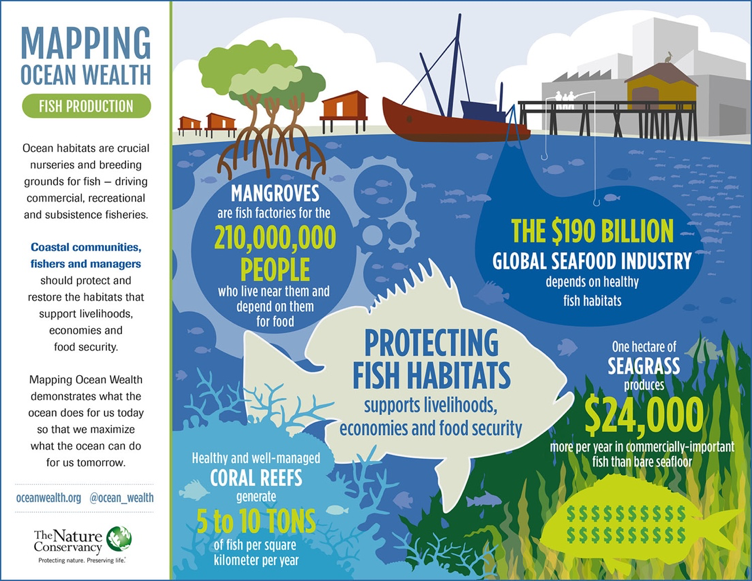
Example of highlighting the benefits of protecting fish habitats from the Mapping Ocean Wealth Project (click image to enlarge).
7. Make Sure Your Message Is Credible
A credible message is simple, clear, and addresses issues up front. It doesn’t over-dramatize, offer facts that are premature, exaggerate, over-promise, or demonize others.
8. Tell a Story
Humans understand the world through stories. Storytelling has been an important part of the human experience—from the etchings of cave dwellers millennia ago to 21st century internet-based storytelling. Research has shown that the human need to communicate in a coherent story is hardwired in our brains. To tell an effective issue-related story, you should begin with why the issue matters (values), then present the problems associated with that issue, ending with what the audience can do about it (illustrated below). Learn more about Storytelling for Social Change from Frameworks Institute. Remember to make sure your story clearly articulates what you want people to do and helps build support for your mission.
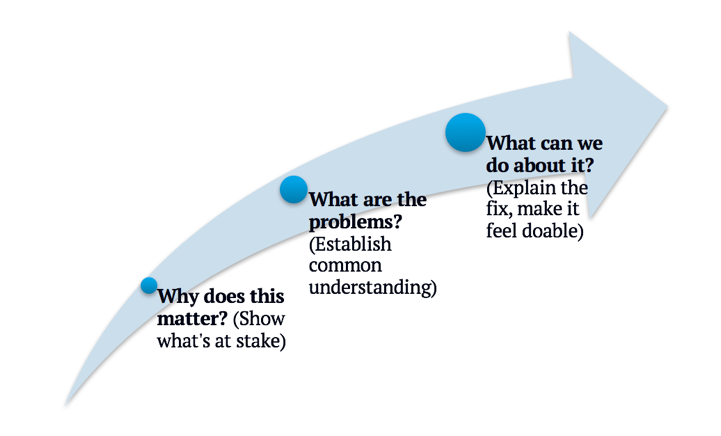
Graphic based on the story arch for social causes from Frameworks Institute.
Writing your Messages – How to Create a Meaningful, Concise, Tangible Message that Resonates with Your Audience
Meet the Message Box, a tool to help you condense information about your work/project into four or five sentences that explain the overarching issue(s), problems that have occurred because of the issue, how your work relates to your audience, the solution (and your audience’s role), and the benefits (to your audience).
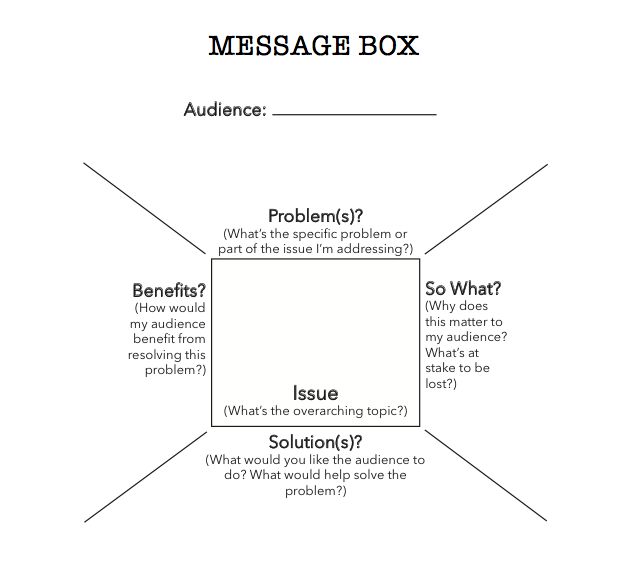
This worksheet is based on the Smart Chart® strategic communications planning tool from Spitfire Strategies and COMPASS’s Message Box.
You begin by identifying your central issue and your target audience. Then streamline your story into concise messages by answering the following questions:
- What are the problems/conflicts associated with the overarching issue?
- Why does this information matter to my audience?
- What are some of the possible solutions to this problem? What action would you like the audience to take?
- What are the potential short, medium, and long term benefits of resolving this problem?
The Message Box can be used for many different communication needs. Here are just a few:
- Writing your strategic communication plan, a story, or a press release
- Preparing for a media interview, community meetings, or one-on-one discussions with key decision-makers
- Designing outreach materials such as brochures and posters
Developing a message using the Message Box is a continuous process. It takes at least two, and possibly as many as five or six iterations to refine it. Feedback from colleagues and peers, as well as test audiences, and input from research and evaluation, may lead to new versions of your Message Box.
COMMUNICATION TIP
We recommend practicing reading your Message Box out loud pretending you are talking to your target audience. Messages sound different when spoken versus read, and a practiced message can sound more natural.
Test Your Understanding
Test your understanding of the information in this section by taking the quiz.
Your Turn (> 45 minutes recommended)
Use the Message Box Worksheet to develop core messaging about your work. We recommend filling it out at least two times to start – draft one will capture the results of your initial brainstorm. Draft two is to help you edit down and decide on the most important messages for your audience.
Draft 1 (recommend at least 30 minutes for first draft):
- Begin by identifying your target audience – who is the message going to be for? Pick one audience from your previous worksheet and write it down on your worksheet. This is who you’re developing your messages for.
- Then identify your overarching issue. What is the issue your project/solution is trying to address? Tip: Because previous activities did not have you identify an “issue,” this step can be a little confusing. To identify your issue, think about the root cause your solution will address, e.g. overfishing, coastal development, polluted runoff, etc. This is an important step, because if you are too focused on the problems, e.g. less and smaller fish in a bay, then it’s harder to convince your audience that a marine reserve is the solution if the decline in fish is due to poor water quality rather than overfishing. It’s ok to have more than one issue to start, you’ll refine in the second draft.
- Next, fill out the other sections of the Message Box, i.e. “Problems, So What, Solution, and Benefits.” Jot down your ideas in bullet format.
Draft 2 (recommend at least 15 minutes for second draft):
On your second Message Box worksheet, refine your messages through the lens of your audience. The goal for this step is to condense the contents of each Message Box section into one or two sentences.
Consider the following questions:
- What does your audience really need to know?
- Will your audience ask “so what?”
- Is your audience’s role in the solution clear, i.e. do they know what you are asking them to do?
- Does your message emphasize reward and convey hope toward success?
- Did you phrase your message using clear, concise language that your audience will understand?

Example of Message Box second draft.
